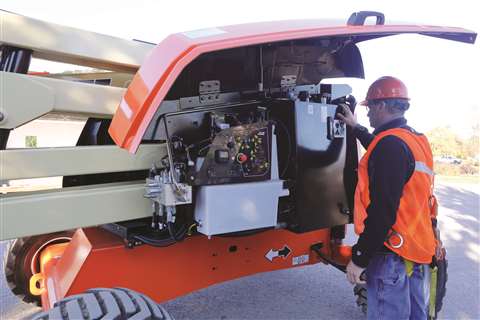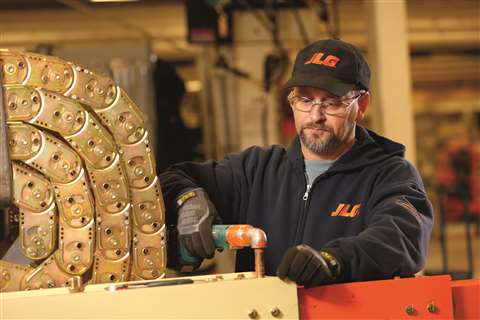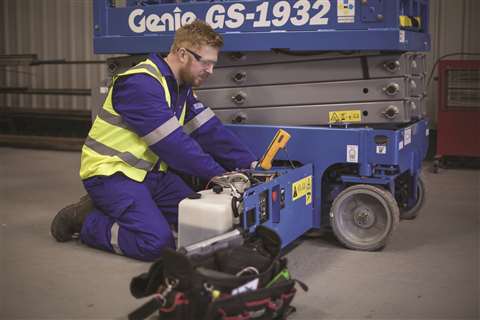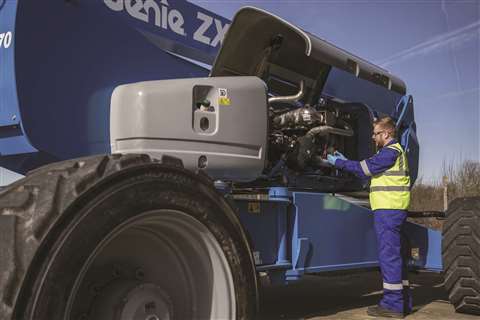Maintenance: Extending the life of AWPs
10 August 2017

Accurate maintenance of an AWP is crucial. Making sure the machine is in optimal condition after use will also allow for high resale rates.
Failing to properly maintain an aerial work platform (AWP) can create costly downtime for rental companies and contractors. With project deadlines to meet, losing the functionality of a boom, scissor or vertical lift can force project extensions, potentially costing thousands of dollars in extra expenses.
Manufacturers provide service manuals which outline proper inspections, maintenance and schedules rental companies and contractors should follow. The manuals include key information on how to perform preventative maintenance to assist with preserving the life of an AWP, resulting in longer uptimes during work shifts and higher resale values.
Outside of the pre-start inspection and annual machine inspection, rental companies and contractors should frequently conduct preventative maintenance on their AWP. By making sure filters are clean, oil is clear and engines are performing properly, emergency maintenance and service procedures can be avoided.
Cleanliness
The single most important maintenance practice in preserving the service life and resale value of an AWP is to keep it clean by making sure dirt and other foreign materials are kept out of all vital components of the machine. Many precautions have been put in place to safeguard against this issue. Shields, covers, seals and filters are provided by manufacturers to keep air, fuel, oil and grease supplies clean. However, these items must be maintained on a scheduled basis to function properly.

If air, fuel or oil lines are disconnected to perform maintenance and service procedures, cover all openings to prevent entry of dirt or other foreign materials. Any trace of dirt in a line can cause damage to the machine.
Keep in mind that during any maintenance procedure, it is common to fit the machine with new parts, like oil and air filters. Keeping all parts inside their containers until installation will prevent dirt from encountering the parts. It will also avoid scratching or scoring of the new parts, which could reduce their service life.
Hydraulic systems
With many AWPs featuring a hydraulic system, fluid cleanliness is key to a long life for the system and its components. The primary enemy of a hydraulic system is contamination. Contaminants enter the system by various means, such as using inadequate hydraulic oil, allowing moisture, grease, filings, sealing components or sand to enter when performing maintenance, or by permitting pumps to cavitate due to insufficient system warm-up or leaks in suction lines.
The smallest amount of dirt or foreign material entering the system can cause wear or damage to close fitting parts like valves, pumps and motors and could result in faulty operation and a shortened service life.
Sometimes, the hydraulic system becomes contaminated and must be drained, flushed and refilled with clean hydraulic oil. A couple instances where the system would need to be drained include evidence of debris found in the hydraulic system or if oil is noticeably cloudy, indicating a high moisture content that can cause oxidation and corrosion. To assess hydraulic oil cleanliness, remove the filters and inspect them, looking for evidence of cloudy oil or metal particles.

Every precaution must be taken to keep hydraulic oil clean, and that includes preserving the oil being stored. Filters should also be checked, cleaned and replaced as necessary at the specified intervals recommended in each machine’s service manual or soon if operated in a harsh environment.
Stick to a regular maintenance routine to keep aerial equipment working harder, lasting longer
In theory, everyone knows that preventive maintenance is the key to keeping equipment running at peak efficiency and to getting a better return on invested capital (ROIC). But in practice, preventive maintenance routines are often postponed, or even neglected, in order to increase rental opportunities.
The reality is that performing routine maintenance tasks can save a rental house a lot of money. Most regular maintenance tasks can be handled in-house, by anyone experienced in aerial work platforms and familiar with a machine’s particular sounds and performance.
Make it a habit

Preventive maintenance is a commitment that needs to be made before, during and after every rental. The maintenance tasks should be simple and easy to follow, yet provide attention to detail – it is easier to deal with things little by little rather than have something fail and face the consequences.
For example, before an aerial work platform goes out on rent it is important to check the water levels in the battery. The condition of the battery is directly linked to the life and longevity of the machine. It is also important to check the oil and coolant levels.
The next step is to walk around the machine, checking for leaks and making sure all the machine’s systems are lubricated and functioning properly – have a grease gun handy to lubricate the systems if necessary.
While completing the visual inspection, be sure to also check:
- Tire wear and condition
- Fastener tightness
- Measurements of the wear pads
- Hose and wiring routing for chaffing
- Component cover latches and hinges
- Decal legibility
- Cable track integrity
- Banjo keeper bolt integrity
At the end of a rental, it is important to wash down the entire unit, including underneath the machine – removing any dirt, dust, sand or other jobsite material that can accumulate and contaminate the machine – and lubricate again, according to the manufacturer’s lubrication plan. During this process, do a visual check for any external or internal damage, repairing and replacing as necessary. This is a good time to take care of paint touch-ups.
A long-term commitment
Good operating condition and extended life expectancy of aerial work platforms are largely influenced by regular care and maintenance. This goes beyond the daily care and feeding of the machine’s systems, it also includes longer-term attention
Every six months, your sales team and service technicians need to have an open discussion about how the equipment is being used day in and day out, as well as how it’s performing in the field. Also at this point, look at the maintenance records to spot any patterns – it is important to look at what components are failing and to determine why, how and when they failed. It is also important to know which components are holding up over time and to analyze those trends. Too often, the little things can be an indication of larger problems. These warning signs should never be ignored.
Some, or all, of these maintenance tasks will affect the residual value and on-the-job performance of the machine, as well as will influence your customers’ perceptions of your rental business and equipment.
Before an AWP goes out on rent it is important to check the water levels in the battery. The condition of the battery is directly linked to the life and longevity of the machine. It is also important to check the oil and coolant levels.
Powertrains
Whether the machine is powered through a combustion engine or battery pack (or possibly both), rental companies and contractors should take certain measures to ensure a long life.
In many combustion engines, specifically diesel, the use of diesel exhaust fluid (DEF) is required. If this system becomes contaminated or the wrong fluid is added, such as screen washer or diesel gas, damage can occur to the injection, ejection system and fluid quality sensing system. Early service intervention is key to protect the life of the system. If the AWP is operated while the DEF system is contaminated, the system life will be significantly shortened.
While batteries are unlikely to become contaminated with foreign material, there is a concern with the risk of corrosion. To clean a battery, use a non-metallic brush and solution of baking soda and water. Once finished, rinse with clean water. After rinsing, thoroughly dry the battery and coat the terminals with an anti-corrosion compound to prevent further corrosion.
Regular maintenance lowers total cost of ownership
Maintaining an AWP can be simple. Equipment owners who regularly clean all aspects of their machine and check the fluids frequently will be rewarded with extended service life. Rental companies may also enjoy a higher resale value for their machine, as a well-kept AWP should sell for much more than an inadequately maintained one.
Maintenance tips for your Tier 4 Final equipment
After decades of preparation, aerials with Tier 4 Final engines are beginning to find their way into your rental fleets.
T4F engines significantly reduce carbon emissions, increase fuel efficiency and allow for longer service intervals.

Electronic diesel engines
It’s important to understand how T4F engines differ from others.
Engine manufacturers have switched from mechanical engines to electronically controlled engines, which means fuel injection and timing that was once controlled by gears, a camshaft and rockers, are now run by an engine control module (ECM). The ECM also regulates the engine’s aftertreatment system to control soot and NOx gas, nitrogen and oxygen compounds released into the environment.
Today’s diesel engines use exhaust gas recirculation (EGR) circuits and/or selective catalytic reduction (SCR) systems to reduce emissions by 50-96 percent. The new technology requires operators and mechanics to think about their machines a little differently than they did before.
Run the engine hot
Unlike the older engines, T4F engines are designed to run hot all the time. The heat ensures that the engine produces the right amount of power, makes sure the piston rings seat properly and helps the aftertreatment system rid pollutants.
Because these engines do run hot, they can burn some oil, so make sure to check oil levels more often and add oil when needed.
Ultra-low-sulfur diesel
The quality of the fuel and oil used in T4F engines is critical. These new engines are designed to run on ultra-low-sulfur diesel and low-ash oil. Older mixes of off-road diesel don’t burn clean enough and cause issues with these engines injection systems and fuel management systems.
The biggest enemy to T4F engines is water. These new high-pressure fuel systems deliver fuel at almost a molecular level. The fuel pump and turbocharger might depend on the fuel for lubrication, and when water is introduced into the system, the results can be costly. So, it’s important to keep fuel clean throughout the fueling process. Whenever possible, avoid the use of gas cans because they can be compromised by water and dirt. And, keep your fuel supply tanks clean.
If an engine malfunctions and you suspect it is related to fuel, take fuel samples immediately.
Fuel water separator
Any product with a 49-hp diesel engine and above will be equipped with a fuel water separator. It is important for operators to be pay attention to the warning indicator light that illuminates when the separator is 70 percent full and have them drain the separator on a daily basis.
Exhaust system
The exhaust system on T4F engines is more robust and heavier than mufflers and catalytic converters on older products, and clamps and mounting brackets should be visibly inspected on a regular basis. Vibration can loosen up clamps, and unnoticed, it could lead to an expensive repair.
Aftertreatment
Depending on the size and make of the T4F engine, aerials might have a diesel particular filter (DPF), which will occasionally have to perform a regeneration process to burn off particle matter trapped in the DPF.
For some machines, enough heat is generated to clear the DPF through passive regeneration and does not impact machine operation. Low-duty cycle machines require active regeneration, requiring the operator to park a machine while it goes through a full manual regeneration.
Whether your aerials perform passive or active regeneration, it’s important to complete the process. Failure to do so will result in machine derating or shutting down to protect the system.
Diesel emissions fluid
If the aerial is equipped with a diesel emissions fluid (DEF) tank, make sure operators are checking the levels on a daily basis. DEF is a colorless, nonhazardous chemical that has been incorporated in most 75-hp engines and higher to help meet Tier 4 emission standards. And, failure to refill DEF will lead to the machine derating or shutting down.
Warning indicators
Pay attention to any dashboard or operator panel warning lights and take immediate action.
Service intervals
Familiarize yourself with recommended service intervals outlined in your aerial’s owners’ manual. Most T4F models have extended intervals when compared to older machines. Do not push filter life; these engines do not tolerate stretching service intervals
Certified training
The EPA put the burden of complying on the manufacturer, which means OEMs are responsible for ensuring aerial equipment meets emission standards. This is why it’s imperative to only have certified mechanics working on these motors. Engine OEMs do offer courses for rental service technicians to become certified, something you might want to consider. With proper training, engine manufacturers will give you more access to equipment and permission to reading and resetting default codes, saving time and money.


